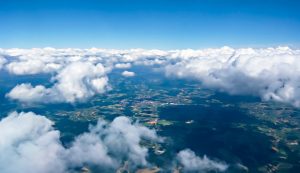Troposphere
 Troposphere is a major error source in Global Navigation Satellite Systems (GNSS) precise positioning, as the GNSS signal delay depends on the pressure, temperature and water vapor content along the signal path. Furthermore, the delay can be divided into a hydrostatic and a wet component (Mendes 1999). Hydrostatic delay of sufficient accuracy can be provided with empirical models. Unfortunately, wet delay depends on the water vapor content, that changes rapidly over time and space. There is no model accurate enough for wet delay, therefore wet delay is usually estimated as an unknown parameter. The wet delays for each GNSS signal in slant direction are mapped into zenith direction using a mapping function. In this way, an epoch-specific parameter ZWD (zenith wet delay) is estimated in the functional model together with other unknown parameters, including receiver coordinates and receiver clock error.
Troposphere is a major error source in Global Navigation Satellite Systems (GNSS) precise positioning, as the GNSS signal delay depends on the pressure, temperature and water vapor content along the signal path. Furthermore, the delay can be divided into a hydrostatic and a wet component (Mendes 1999). Hydrostatic delay of sufficient accuracy can be provided with empirical models. Unfortunately, wet delay depends on the water vapor content, that changes rapidly over time and space. There is no model accurate enough for wet delay, therefore wet delay is usually estimated as an unknown parameter. The wet delays for each GNSS signal in slant direction are mapped into zenith direction using a mapping function. In this way, an epoch-specific parameter ZWD (zenith wet delay) is estimated in the functional model together with other unknown parameters, including receiver coordinates and receiver clock error.
Although ZWD is treated as an error source in precise positioning, there is great potential of exploiting ZWD for weather and climate monitoring (Bianchi et al. 2016, Guerova et al. 2016). The very dense network of GNSS receivers distributed worldwide becomes a powerful tool for remote sensing of water vapor in the troposphere, called GNSS meteorology (Bevis et al. 1992). Compared to other existing techniques for water vapor monitoring like water vapor radiometers or balloon radio-sounding, GNSS meteorology operates in all weather conditions and provides homogenous products of spatial and temporal resolution higher than any other tropospheric sensing technique (Vedel et al. 2001, Hernandez-Pajares et al. 2001).
The troposphere estimates are applied in weather forecasting as an additional water vapour observation (Bennitt and Jupp, 2012), as the numerical weather prediction model is usually run every 6 hours, the data latency is not so crucial the Near Real Time delivery (90 minutes delay) is acceptable. GNSS and Meteo has developed its own NRT GNSS processing engine based on Bernese 5.2 (Bosy et al., 2012) and provides GNSS estimates for EGVAP project.
Recent developments in provision of real-time clocks and orbits (Hadaś and Bosy, 2015), allows for high quality estimation of GNSS observations (Yuan et al., 2014) that allows for real-time monitoring of weather. It opens up a new applications for GNSS observations as an additional data source for nowcasting applications. GNSS and Meteo, has developed an in-house real-time multi-GNSS processing software GNSS WARP (Hadaś, 2015).
We think that the future of GNSS-based troposphere retrievals is linked with: real-time estimation of direct – slant observations, higher order refractivity estimation, and signal attenuation use.
References:
Bennitt, G. V., & Jupp, A. (2012). Operational assimilation of GPS Zenith Total Delay observations into the Met Office numerical weather prediction models. Monthly Weather Review, 140(8), 2706-2719.
Bevis M, Businger S, Chiswell S, Herring TA, Anthes RA, Rocken C, Ware RH (1992) GPS meteorology: remote sensing of atmospheric water vapor using the global positioning system. J Geophys Res 97(D14):15787–15801
Bianchi CE, Mendoza LPO, Fernandez LI, Moitano JF (2016) Multi-year GNSS monitoring of atmospheric IWV over Central and South America for climate studies. Ann Geo 34(7):623-639. doi: 10.5194/angeo-34-623-2016
Bosy, J., Kaplon, J., Rohm, W., Sierny, J., & Hadas, T. (2012). Near real-time estimation of water vapour in the troposphere using ground GNSS and the meteorological data. In Annales Geophysicae (Vol. 30, No. 9, pp. 1379-1391). Copernicus GmbH.
Guerova G, Jones J, Dousa J, Dick G, De Haan S, Pottiaux E, Bock O, Pacione R, Elgered G, Vedel H, Bender M (2016) Review of the state-of-the-art and future prospects of the ground-based GNSS meteorology in Europe. Atmos Meas Tech Discuss. doi: 10.5194/amt-2016-125
Hadas, T., & Bosy, J. (2015). IGS RTS precise orbits and clocks verification and quality degradation over time. GPS Solutions, 19(1), 93-105.
Tomasz, H. (2015). GNSS-Warp Software for Real-Time Precise Point Positioning. Artificial Satellites, 50(2), 59-76.
Hernández-Pajares M, Juan JM, Sanz J, Colombo OL, Van der Marel H (2001) A new strategy for real-time integrated water vapor determination in WADGPS Networks. Geophys Res Lett 28(17):3267-3270
Mendes VB (1999) Modeling the neutral-atmospheric propagation delay in radiometric space techiniques. PhD dissertation, University of New Brunswick
Vedel H, Mogensen K, Huang XY (2001) Calculation of Zenith Delays From Meteorological Data Comparison of NWP Model, Radiosonde and GPS Delays. Phys Chem Earth 26:497–502. doi: 10.1016/S1464-1895(01)00091-6
Yuan, Y., Zhang, K., Rohm, W., Choy, S., Norman, R., & Wang, C. S. (2014). Real‐time retrieval of precipitable water vapor from GPS precise point positioning. Journal of Geophysical Research: Atmospheres, 119(16), 10044-10057.
